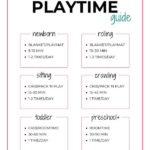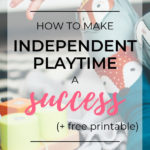How To Make Independent Playtime A Success
Getting your child to play independently is easier than you think! Scroll through this post to learn all about playtime lengths along with tips for making Independent Playtime a success.
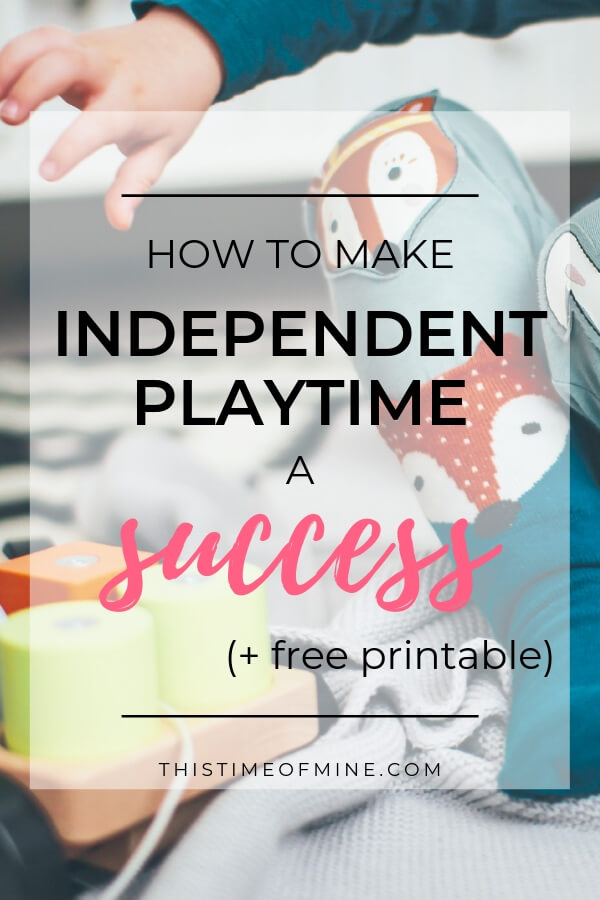
Have you ever heard, “It’s good for your child to play alone” and thought, ya…but how?
It’s easier than you think!
You just need a few simple tips to get you started. And before you know it, you’ll be enjoying a nice, quiet break at the same time your little girl or guy is growing, developing and having fun. Sound too good to be true? It’s not.
So how do you get started? How long should it be? And how is it different than regular playing?
Read on to get all the answers along with a few bonus tips. And because I love this parenting tool so much, I want to make sure you’re not missing out on any great info. So first: a little background on this post.
OVERVIEW
This is the 3rd post in the Independent Playtime series – a series where you’ll learn all about Independent Playtime and how to use it.
If you’d like a place to start, read Get to Know the Magic of Independent Playtime to learn what it is along with its main purpose.
And if you’re curious about why it’s so great, hop on over to 20 Amazing Benefits of Independent Playtime.
In today’s post, you’ll learn all about the best playtime practices for each age. I’ve also included 10 tips to help you get started.
Ok, let’s jump right in.
WHEN SHOULD I START INDEPENDENT PLAYTIME?
Right away! You can start in the newborn days.
But don’t worry, it’s never too late to start! Just a little heads up – starting later sometimes means there might be some resistance at first. But if you stick with it, they’ll learn to enjoy it too.
HOW LONG SHOULD IT BE?
At first, you might consider yourself lucky to just get 5 minutes alone! But on other days, you might be tempted to stretch it out as long as possible. (We’ve all been there.)
Yes, it’s break time for you too. But it’s main goal is to benefit your child. So it needs to be planned and structured. But it’s not complicated, I promise.
Here are some guidelines to get you going:
NEWBORN
Between diaper changes, feedings, naps and cuddles it might seem impossible to find time for playtime this young. But starting right away will be good for you and your baby.
Lay your baby on a blanket or on a playmat for 5-10 minutes, 1-2 times per day. At this young age, you don’t need to worry about leaving the room.
Unless you’re need to squeeze in a quick potty break or a snack! Newborn days can be rough sometimes!
ROLLING
When your baby starts to roll, you can increase the time to 10-20 minutes, 1-2 times per day. Set him up on a playmat or blanket with a couple toys and go to a place he can’t see you.
SITTING
Once your baby is sitting, it’s time to transfer playtime to a crib or pack ‘n play. Aim for 15-30 minutes, 1-2 times per day.
Make sure the atmosphere is very different from naptime. Open the blinds, talk to her in a playful voice, and don’t forget to set her up with a few of her favorite toys.
CRAWLING
As your baby gets older, 15 minutes might still be plenty. But by this age, she could go as long as 45 minutes if she can handle it. You can aim for 1 time per day now.
TODDLER
Playtime can now be 30-60 minutes, once per day. And when he seems ready, it may be time to switch to Roomtime.
Remember, all of these are just suggestions. You know your child best. Customize the times to fit your needs.
Also, if your child is starting out older or is having a hard time, you can start with 5-10 minutes and go longer in 5-10 minute increments.
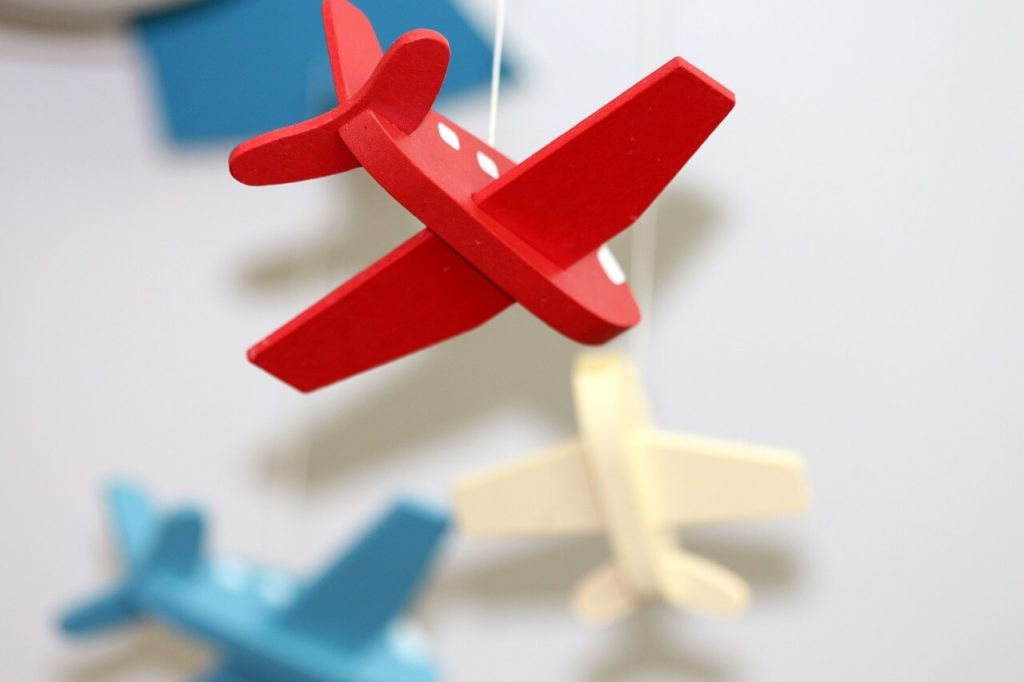
SO HOW DO I GET STARTED?
Independent Playtime can be something you and your child look forward to each day. And keeping it simple and fun will help it be a success.
Here are 10 tips to keep in mind:
1. PICK A GOOD TIME
Pick a time of day your child is usually alert and happy. (Try to avoid being too close to naptime.)
The exception to this would be when your baby is older and you are using playtime to transition out of naps.
2. BE CONSISTENT
Consistency is crucial for your child to go longer. Of course, you’ll still have busy days where you won’t be able to fit it in. But do it as often as you can.
3. STICK WITH IT
This is especially true if your child has a hard time with playtime at first. Don’t give up! It’ll get better with time. He’ll get to a point where he looks forward to Independent Playtime as much as you do!
4. START SMALL
Don’t worry if your child can only handle 5-10 minutes at a time. She’ll work up to longer periods of time. (Either as she gets older or gets better at playing alone.)
5. PICK THE RIGHT AMOUNT OF TIME
The Independent Playtime Guide has all the information from above, but in a nice, easy format for you to reference! You can download it for free if you’d like a copy to print out at home.
Remember, these are just guidelines. You know your child best. Do what works for him. But don’t be afraid to lengthen playtime as he gets better at it!
6. YOU CHOOSE THE LOCATION
Independent Playtime is different than just letting your child play alone. It’s a structured part of your routine. So although it can be tempting to let her choose where to play, it still needs to be your choice – especially when she’s ready to transition to Roomtime.
Enforcing boundaries here isn’t mean or too strict. It’s part of what makes this so beneficial!
And don’t forget to set the right atmosphere! If playtime is in the same place she sleeps, make sure it feels totally different. Open the blinds, maybe even turn on some soft music. Do whatever you’d like to make it a fun, playful environment.
7. PICK THE RIGHT TOYS.
One of the goals of Independent Playtime is to teach your child to focus on what she can do with the things she has. It sparks creativity and ingenuity, among other things.
So rather than letting her play with anything and everything, set out some toys for her. But stay away from screens. (TV, iPads, etc.)
And to avoid frustration, stay away from toys that are too challenging or activities she still needs help with. Toys that are too easy can also lead to boredom and frustration.
Just do your best to pick toys that are developmentally appropriate, and she’ll have fun. And don’t forget to rotate them occasionally!
8. REMAIN OUT OF SIGHT
Independent Playtime is alone time. This is key to it being fully beneficial for your child.
Try to pick areas where you can check on him without him seeing you, especially if playtime is still new. Set up a baby monitor or remain in earshot (safety is important!) but stay out of sight.
Most of my children found it harder to play if they could see or hear me.
9. CLEAN UP
End each playtime by having your child help clean up. This will help her learn the importance of helping and of cleaning up after herself. And don’t forget to sing a song and make it fun!
10. PRAISE, PRAISE, PRAISE
At the end of each playtime, build him up. Praise him for staying in playtime. Praise him for helping you clean up. Lots of praise will reinforce this good routine you’re trying to develop and will help him grow to love playtime even more!
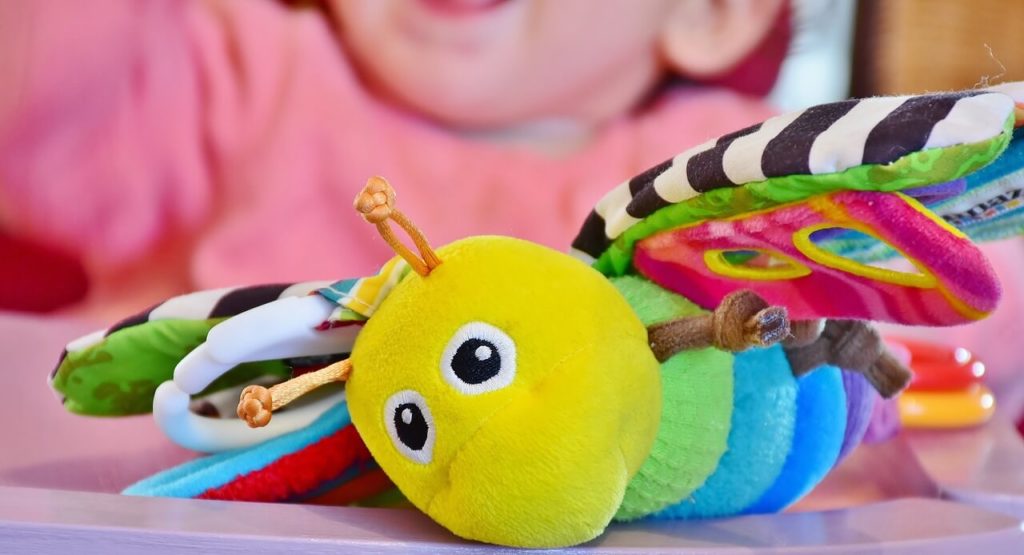
CONCLUSION
I absolutely love Independent Playtime. Being told to try it was one of the best bits of parenting advice I’ve ever received. I’ve used it with all 4 of my children and continue to see the benefits of it every day.
It’s so much more than just leaving a child to their own devices for awhile. It’s structure sets children up for the development of skills they can use for years to come.
Stay consistent, and choose your timing and toys wisely. And soon, you and your child will grow to love Independent Playtime as much as we do!
If you have any other questions about Independent Playtime, I’d love to hear from you in the comments below. You can also refer to the other posts in the series.
- Get To Know The Magic Of Independent Playtime
- 20 Amazing Benefits of Independent Playtime
- Daily Quiet Time- How To Use Roomtime With Your Toddler
- Independent Playtime: When It’s Just Not Working
- How To Reign In The Playtime Mess
want to remember this?
PIN IT TO YOUR FAVORITE BOARD
Share this article:

